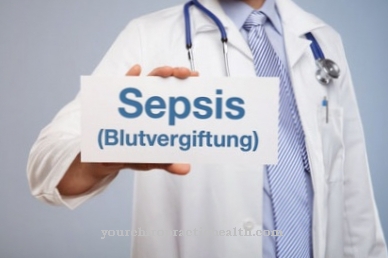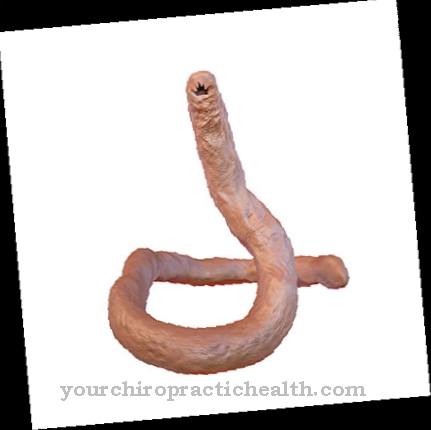A Hip dysplasia, Hip dislocation or Hip dislocation is a misalignment of the hip joint in which the joint head is not stable in the acetabulum. If treated early, the hip dysplasia can heal completely. It can be prevented with the right measures, even if there is a genetic predisposition to it.
What is hip dysplasia?
.jpg)
© Portos - stock.adobe.com
The Hip dysplasia is an incorrectly created or disturbed acetabular cup. The so-called acetabular roof is either not properly formed or not sufficiently ossified, but rather still cartilaginous and soft.
As a result, the head of the thighbone does not find a hold in the acetabulum, which can lead to a malalignment and dislocation (hip dislocation). Hip dysplasia is one of the most common congenital malformations of the skeleton, it occurs in approximately 4% of all newborns. The defective acetabulum usually forms on both sides, sometimes unilateral malformations also occur.
Girls are about 4-6 times more likely than boys. Hip dysplasia usually only becomes clearly visible after birth. If left untreated, hip arthrosis (joint deformation) can develop in later years.
causes
The exact causes of the Hip dysplasia are not yet known. There are different approaches to the development of the malformation and a distinction is made between genetic, mechanical and hormonal causes. If there are several cases of hip dysplasia within a family, it is assumed that there is a genetic predisposition.
Mechanical causes are suspected in confined spaces in the uterus, as is the case, for example, in multiple pregnancies. An unfavorable position of the embryo, especially the breech position, represents an increased risk of developing hip dysplasia and is also one of the mechanical triggers.
Another possible cause is the hormonal change in a pregnant woman's body. During pregnancy, hormones are formed that cause the mother's pelvic ring to relax. This effect can also spread to the female fetus, which explains the fact that significantly more girls suffer from hip dysplasia than boys.
Other possible causes are high blood pressure in the mother during pregnancy and too little amniotic fluid in the uterus.
Symptoms, ailments & signs
Congenital hip dysplasia often causes no symptoms and in many cases heals spontaneously before a hip dislocation can develop. In the case of hip dysplasia, the joint socket is deformed. It depends on the extent of the dysplasia, to what extent a dislocation, i.e. a partial or complete displacement of the femoral head out of the joint socket, develops.
Hip dysplasia with hip dislocation is characterized by an unstable hip joint (Ortolani sign). With the Ortolani sign, a click is heard when the baby's legs are spread apart and spread apart. This click is caused by the correct displacement of the joint head into the joint socket. Another symptom is that the leg is inhibited from spreading at the affected area.
In addition, the femoral head dislocates itself again and again when the legs move in and out. This symptom is also known as the Barlow's sign. With unilateral hip dislocation, the folds on the back of the thighs appear asymmetrical. In addition, the leg on the affected side also appears to be shortened in this case.
A unilateral hip dislocation occurs in around 60 percent of cases. The extent of hip dysplasia with hip dislocation is not uniform at birth. In addition to many mild forms of the disease, there are already fully developed hip dislocations. In severe dysplasias, early treatment is necessary to prevent the femoral head from completely dying off.
Diagnosis & course
The Hip dysplasia can be clearly present at birth or only develop afterwards, which is much more common. Typical symptoms are an unstable hip joint (Ortolani sign) and asymmetrical folds on the back of the thighs.
The affected leg appears shorter and the femoral head can be easily pushed out of the socket and back again (Barlow symbol). With an ultrasound examination (sonography) the hip dysplasia can be made visible and the doctor can see to what extent the acetabular roof is ossified.
An X-ray also clearly shows an existing hip dysplasia, but is usually not used for purely diagnostic purposes, but rather to document the course of treatment and to check whether a joint has already deteriorated.
If the hip dysplasia is diagnosed immediately after birth, the chances of recovery are greatest. If the malformation is not recognized, it can lead to circulatory disorders over time and the bone tissue of the femoral head can be damaged and die as a result.
Complications
Hip dysplasia usually leads to a malalignment in the hip joint. In most cases, this misalignment is associated with severe pain and restricted mobility and thus always leads to a reduced quality of life for the patient. The hip joint itself feels very unstable and can therefore be dislocated very easily.
This can occur especially with light bumps or jerky movements and thus limit the everyday life of the person concerned. The pain from the hip can also spread to other regions of the body and cause discomfort there as well. It is not uncommon for long-term pain to lead to depression and other psychological complaints or moods. Usually one of the legs is also shortened.With an early diagnosis and treatment, hip dysplasia can be treated relatively well and completely.
There are no further complications or other complaints. With the help of various therapies, the joint can be stabilized again so that the symptoms disappear completely. Surgical intervention is only necessary in serious cases. Life expectancy is not affected by hip dysplasia. However, the person concerned may be limited in the ability to perform various sports in their life.
When should you go to the doctor?
A visible malposition of the hip joint must be clarified by a doctor. If there are any additional signs of hip dysplasia, it is best to seek medical advice immediately. Movement restrictions in the area of the hip joint must always be clarified by a doctor. Medical advice should also be obtained with externally visible bone changes.
Parents who notice the signs of hip dysplasia in their child are best to speak to the pediatrician. If the misalignment does not develop until later in life, a doctor must be consulted with unusual symptoms and unspecific pain, who can clarify the symptoms and, if necessary, initiate treatment directly. Hip dysplasia mostly affects girls and often occurs as a result of complications during pregnancy. Mothers who have hormonal problems or high blood pressure during pregnancy are at increased risk of having a child with hip dysplasia. Anyone who belongs to these risk groups should consult the responsible doctor. The child can then be examined and medicated immediately after birth.
Doctors & therapists in your area
Treatment & Therapy
Treating a Hip dysplasia depends on how difficult it is trained. If there is only a slight malformation, a special swaddling technique with extra wide diapers or spreading pants is usually sufficient.
These measures flex the hips and spread the legs apart, which means that the joint head is pushed deep into the acetabulum and the joint is stabilized. Physiotherapy exercises are also recommended. If the femoral head repeatedly jumps out of the socket, bandages or splints are attached to keep the joint head stable in the socket. In some cases, the joint is immobilized with a plaster splint.
With these treatments, slight hip dysplasias often heal during the first year of life. If hip dysplasia is diagnosed late and the misalignment has already caused damage to the bone, surgery is usually necessary to bring the joint back into the correct position and to stabilize it.
prevention
Most Hip dysplasia develop only after birth. To avoid this, simple measures are often sufficient. So you shouldn't stretch a baby's hip too early. The natural posture is the flexed position in which the hip joint can fully mature. Avoid placing the baby in the prone position too early and too often, as this will stretch the hips. Carrying the baby in a cloth, on the other hand, supports the correct posture in order to prevent hip dysplasia.
Aftercare
Follow-up care for hip dysplasia (hip dislocation) in childhood differs from follow-up care for the same in adulthood. In childhood, follow-up care for hip dysplasia (hip dislocation) lasts until growth has ended. Regular check-ups prevent the risk of tardive dysplasia. An X-ray is necessary during the major growth phases (at the age of 1.5 years, after the start of the run, as well as shortly before school enrollment and at the beginning of puberty).
Further treatment or a new treatment concept depends on these findings. Wearing a splint or a sit-squat cast, renewed and corrective adjustment of the joint by holding the femoral head in the socket (operative) or extension treatment.
In adulthood, regular follow-up care after surgery to correct hip dysplasia (hip dislocation) is also necessary. These include: Partial stress on forearm crutches, physiotherapy and bandages to avoid secondary diseases. Corrective operations (on the hip socket and / or on the thigh) can be carried out at any age and prevent joint wear (osteoarthritis) of the hip.
If there is secondary hip dysplasia that has been treated with conservative measures (splint fitting, Botox injections), an operative measure may be necessary as part of the follow-up care. The severity, underlying disease and age are taken into account in the surgical measure. Combined interventions (bone corrections with soft tissue interventions) are common.
You can do that yourself
Self-help options for hip dysplasia depend on the age of the patient. Hip dysplasia often shows up in infants, so that it is the parents' responsibility to deal with the disease appropriately. With the right measures, for example a special swaddling technique or wearing spreading pants, the parents have a positive influence on the course of the disease. Undetected and untreated, hip dysplasia often leads to serious complaints later in the patient's life, which are associated with a reduced quality of life.
Even with successful therapy in infancy, follow-up checks are still necessary in children to ensure that the joint continues to develop without complications during growth. If problems arise, the affected children take part in physiotherapy and follow medical advice on exercising. Also prescribed shoe insoles to correct misalignments are to be worn.
If adults still have symptoms from congenital hip dysplasia, they often last for a lifetime. For example, some patients develop early osteoarthritis in the affected joints. Persistent pain can sometimes lead to depression, so the affected person visits a psychotherapist.


.jpg)





















.jpg)



